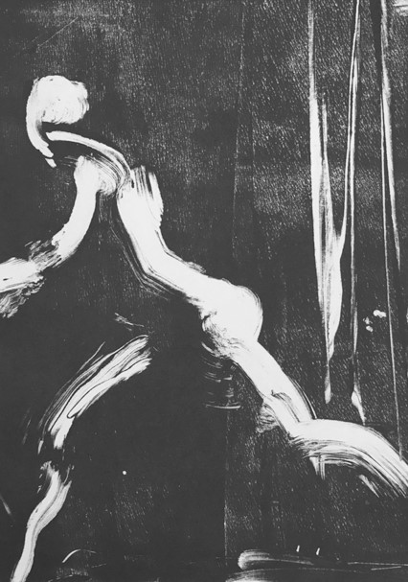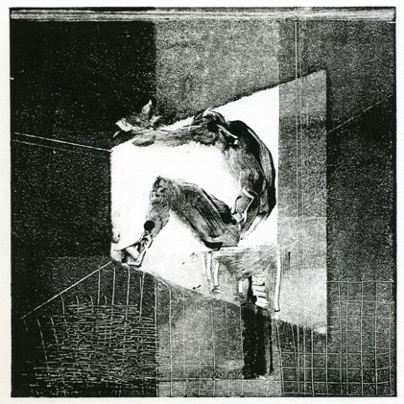Clive Knights
Portland State University, Portland, USA knightsc@pdx.edu

Stride, monotype, 2016, by the author
This workshop sets out to offer what Merleau-Ponty refers to as a ‘conspiration,’ metaphorically speaking, an opportunity to conspire with a limited array of media through manual embrace, in luring new figures out into the open through a process of ardent caress and earnest pressure of the fingertips. We will engage in this figuration by means of a primitive form of monotype printmaking, each participant utilizing a mylar plate, slow-drying acrylic paint, a brayer, simple tools such as a square, bamboo kebab sticks, brushes, cloth, paper, burnishing implement and, of course, animate fingers, hands, arms, and torso.
Through persistent acts of marking up and pressing down, of combining the horizontal gesture of striation across surface (drawing into ink upon plate), and the vertical gesture of impression calibrated to the strength of the printmaker’s body (burnishing the inked plate upon paper by hand), a partnership will be explored between corps and matter, a spatial conversation through corporeal encounter where media and flesh find a mutual reciprocity. The prints will emerge from a collaborative faith in what is possible when bodies (artist and material) engage, fluctuating
2017 Architecture, Culture, and Spirituality Symposium (ACS9) 1 of 2 between relinquishment to each other and wrestling free, inhabiting the tension of these reciprocal tendencies, stretched out together in convulsive gesture.
Historically, the somewhat illegitimate offspring of painters at play in the print-makers world, monotypes occupy a fascinatingly peripheral territory in the world of art. By not being reproducible, the ‘painterly print,’ as the monotype is often referred to, falls outside the traditional canon of printmaking where ‘editions’ prevail as a defining characteristic. The 17th century Genovese painter Castiglione is typically credited with the earliest explorations of this distinctly innovative process whereby a blank, unmarked plate is fully inked and then, through a subtractive process of wiping and scraping, an image is formed and then transferred onto paper through the application of pressure. Rembrandt’s ‘creative wiping’ of plates made evocative use of the technique, as did Degas in what is perhaps the most widely known collection of monotype studies, their dissemination through publication in the 1960s certainly contributing to a resurgence of interest in the medium by 20th century artists.
My own introduction came through an encounter with an exhibition at the de Young Museum in
San Francisco in 2009 of newly acquired monotypes that issued from a collaboration between Nathan Oliveira and Richard Diebenkorn over two days in 1975. Through this I discovered not only the medium but the utterly entrancing collection of Oliveira monotypes emerging in the early seventies, such as the Rembrandt’s House series inspired by Rembrandt’s prints, the
Tauromaquia 21 series, inspired by Goya’s 1816 series of etchings of a bullfight, and in particular the multiple series addressing ‘site’ that manage to conjure an atmosphere of ineffable depth from what is fundamentally a manual, gestural act within a thin film of fluid across a surface transubstantiated by nothing more than the application of pressure.
The alchemy of this process is captivating, and like Castiglione and Oliveira the workshop will engage with the dynamics of chiaroscuro, whereby the surface of the plate, thick mylar, the picture plane so to speak, is obliterated in the first act, thrown into darkness, wiped out by an homogenous application of ink, then wiped over, drawing the constituents of new figures into existence from indiscriminate blackness, a return to light and towards figuration from the place of its negation. Subject-matter will illuminate in gestures from the dark. Each work will endeavor to embody the urgency of desire to capture a world at the cusp of its emergence; to harness new figures at the point at which they are disclosed by auroral luminosity; to make marks in reply to the generosity of the unfathomable.

Predicament, monotype, 2010, by the author



